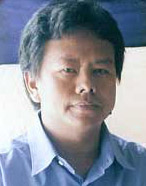 |
||
|---|---|---|
| CP Foundation | About CP Biennale | 2003 | 2005 | Contact Us | >||
           
|
||
|
In 1988 he was offered the opportunity to sculpt a wooden model for the sculpture of a soldier to be displayed at the Keraton Kasunan Palace in Surakarta (Solo). With his extensive experience with carving and some basic experience with sculpting reliefs, he was able to finish this work within a short period of time. Then, for four months, he worked on restoring aging and damaged colonial period bronze sculptures in different places. In 1989, Sartono met Ivan Sagito, a painter who frequently uses the images of cattle in his surrealistic paintings. Ivan asked Sartono to interpret and translate one of his two dimensional works into a three dimensional piece. This was certainly far from an easy task. Besides the mediums being on a much different scale of intensity, the materials used were also radically dissimilar. Sartono calculated and recalculated the scale and visual impact of the objects in the painting he was using as a reference before he even began the work. As it turned out, this project went very well and was a success. His experience with carving and the production of craft pieces has influenced Sartono's sculptures with the tendencies characteristic of a craftsman. Before beginning a work, this artist studies the figures he is taking as objects for his art carefully, and then he processes the work thoroughly. However, his interest in and tendency toward realism does not make Sartono simply a copier of existing forms. He consistently allows space for creative freedom. This includes space for the development of new interpretations. In this biennale, he is exhibiting the sculpture of a fish made from mahogany. This fish with its gaping mouth and sharp teeth is depicted in a very detailed manner. Unexpectedly, he places the fins of the fish in such a way that they come together to form a base for the figure of the fish to stand on. Even though this work is detailed and realistic, Sartono is actually only picturing the image of a fish from the head to the stomach. The rest of the figure of the fish is lost in the transition from the natural form of the wood into that of the form of the fish. A metamorphosis is what Sartono is presenting here; a piece of wood becoming a depiction of an image. Or perhaps there is something symbolic in this piece. This particular work is much different than most sculptures that Sartono has displayed previously. In this piece we can see that Sartono's works do shift and change from time to time. Asikin Hasan Born on September 14, 1962 in Wonogiri. SELECTED GROUP EXHIBITIONS |
||
|
CP Foundation | About CP Biennale | 2003 | 2005 | Contact Us
Jl. Suryopranoto 67A, Jakarta 10160, Indonesia. ph. +62.21.3448126, 3853206 | fax. +62.21.3853203, 3853208 info@cp-foundation.org |
||
 Initially, Sartono studied painting at the SMSR in Yogyakarta, while apprenticing as a wood carver under the tutelage of one of his uncles living and working in the same city. It was during this period of time that, besides practicing the crafts of carving and sculpting reliefs, Sartono gained and immense amount of knowledge about the qualities and nature of wood, especially about teak. It is this medium that he later made the main material for his various sculptures.
Initially, Sartono studied painting at the SMSR in Yogyakarta, while apprenticing as a wood carver under the tutelage of one of his uncles living and working in the same city. It was during this period of time that, besides practicing the crafts of carving and sculpting reliefs, Sartono gained and immense amount of knowledge about the qualities and nature of wood, especially about teak. It is this medium that he later made the main material for his various sculptures.